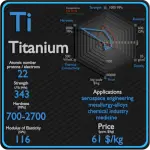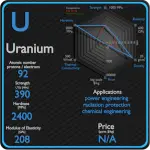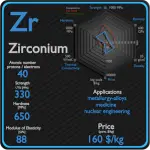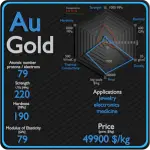This article contains comparison of key thermal and atomic properties of zirconium and tungsten, two comparable chemical elements from the periodic table. It also contains basic descriptions and applications of both elements. Zirconium vs Tungsten.

Zirconium and Tungsten – About Elements


Source: www.luciteria.com
Zirconium and Tungsten – Applications
Zirconium
Most zircon is used directly in high-temperature applications. This material is refractory, hard, and resistant to chemical attack. Because of these properties, zircon finds many applications, few of which are highly publicized. Its main use is as an opacifier, conferring a white, opaque appearance to ceramic materials. Zirconium and its alloys are widely used as a cladding for nuclear reactor fuels. Zirconium alloyed with niobium or tin has excellent corrosion properties. The high corrosion resistance of zirconium alloys results from the natural formation of a dense stable oxide on the surface of the metal. This film is self healing, it continues to grow slowly at temperatures up to approximately 550 °C (1020 °F), and it remains tightly adherent. The desired property of these alloys is also a low neutron-capture cross-section. The disadvantages of zirconium are low strength properties and low heat resistance, which can be eliminated, for example, by alloying with niobium.
Tungsten
Tungsten is widely used metal. Approximately half of the tungsten is consumed for the production of hard materials – namely tungsten carbide – with the remaining major use being in alloys and steels. Mining and mineral processing demand wear-resistant machines and components, because the energies and masses of interacting bodies are significant. For this purposes, materials with the highest wear-resistance must be used. For example, tungsten carbide is used extensively in mining in top hammer rock drill bits, downhole hammers, roller-cutters, long wall plough chisels, long wall shearer picks, raiseboring reamers, and tunnel boring machines. The remaining 40% is generally used to make various alloys and specialty steels, electrodes, filaments, wires, as well as diverse components for electric, electronic, heating, lighting, and welding applications. High-speed steels are complex iron-base alloys of carbon, chromium, vanadium, molybdenum, or tungsten (as much as 18%), or combinations there of.
Zirconium and Tungsten – Comparison in Table
| Element | Zirconium | Tungsten |
| Density | 6.511 g/cm3 | 19.25 g/cm3 |
| Ultimate Tensile Strength | 330 MPa | 980 MPa |
| Yield Strength | 230 MPa | 750 MPa |
| Young’s Modulus of Elasticity | 88 GPa | 411 GPa |
| Mohs Scale | 5 | 7.5 |
| Brinell Hardness | 650 MPa | 3000 MPa |
| Vickers Hardness | 900 MPa | 3500 MPa |
| Melting Point | 1855 °C | 3410 °C |
| Boiling Point | 4377 °C | 59300 °C |
| Thermal Conductivity | 22.7 W/mK | 170 W/mK |
| Thermal Expansion Coefficient | 5.7 µm/mK | 4.5 µm/mK |
| Specific Heat | 0.27 J/g K | 0.13 J/g K |
| Heat of Fusion | 16.9 kJ/mol | 35.4 kJ/mol |
| Heat of Vaporization | 591 kJ/mol | 824 kJ/mol |













